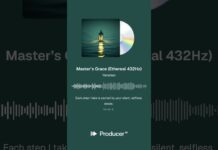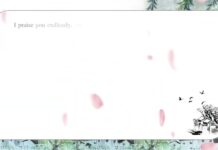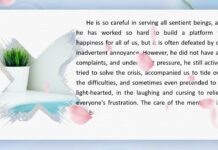Author: Fafu
Translator : Lotus
Dear Dharma friends!
Hello everyone. Welcome to this episode of the podcast contributed by the Buddhas’ Practice Incorporated of Australia.
Today, let’s delve into the profound teaching of the Eight Returns to Discern the Nature of Perception, a remarkable method by which the Buddha, with his supreme wisdom, guided Ananda and the assembly to realize the true nature of perception. Through the logical discourse of the ‘Eight Returns,’ the Buddha systematically ‘returned’ or attributed all external, conditioned, and changeable phenomena to their sources. This process ultimately revealed the one thing that cannot be returned—the subtle, bright, and unchanging true mind, which is the nature of perception itself.
1. Ananda’s Confusion: Mistaking the Buddha’s Voice for His True Nature
Before the ” Eight Returns to Discern the Nature of Perception,” Ananda mistakenly believed the sound of the Buddha’s Dharma talk to be his true nature, thinking that was the true mind. The Buddha compassionately pointed out that sound is merely a “form of sound-dust,” something that can be “returned” to the speaker. If the nature of perception could also be returned, then Ananda’s true nature would cease to exist. This line of questioning directly addressed Ananda’s mistaken attachment, leading to the core of the “Eight Returns”: that the nature of perception cannot be returned. It is the unconditioned, unborn, and undying true nature of the mind.
2. The Eight Returns to Discern the Nature of Perception: Restoring Phenomena, Revealing True Seeing
The Buddha lists eight environmental phenomena—light, darkness, penetration, obstruction, conditions, dull emptiness, distortion and bright purity—and explains their “return” one by one. By peeling away all changeable phenomena, the true nature of perception is revealed.
Light Can Be Returned to the Sun: Brightness depends on the sun; without the sun, there is no brightness. Thus, brightness returns to the sun.
Darkness Can Be Returned to the New Moon: Darkness arises due to the new moon (the new moon at midnight) or clouds and mist. Thus, darkness returns to the black moon.
Penetration Can Be Returned to the Doors and Windows: Penetration is perceived because of open doors and windows. Thus, penetration returns to doors and windows.
Obstruction Can Be Returned to the Walls and Eaves: Blockage appears due to walls obstructing. Thus, obstruction returns to walls.
Conditions Can Be Returned to Distinctions: Differentiated phenomena arise from discerning what is perceived. Thus, the conditions return to discrimination.
Dull Emptiness Can Be Returned to Emptiness: The phenomenon of emptiness exists due to the void. Thus, the dull emptiness returns to emptiness.
Darkness and Distortion Can Be Returned to Mist and Haze: Turbidity and defilement arise from the action of dust. Thus, darkness and distortion return to mist and haze.
Bright Purity Can Be Returned to Freshness: Purity and brightness appear due to the clearing of rain and clouds. Thus, bright purity returns to freshness.
The Buddha asked Ananda: After these eight phenomena are returned to their respective causes, to whom should you return the essence of your seeing?
If the seeing essence were returned to “brightness,” then in the absence of brightness (such as in darkness), you should not be able to see the dark. Yet you can still see the darkness, proving that the seeing-nature does not depend on brightness.
If the seeing-nature depended on other phenomena, then as those phenomena arise and cease, the seeing-nature should disappear along with them. Yet, regardless of brightness or darkness, penetration or obstruction, the seeing-nature remains unchanged.
The Buddha concluded: “All that can be returned is naturally not you; that which cannot be returned, who else could it be but you?” All phenomena that can be returned are not the true you; that seeing nature, which cannot be returned, is precisely your true mind!
3. Characteristics of the Seeing-Nature: Non-Material, All-Pervading, and Unchanging
The Buddha further elucidated the three characteristics of the seeing nature, dispelling mistaken understandings about it:
The Seeing Nature is Non-Material: The seeing nature is not a tangible object, nor is it an external “shadow of preceding conditions.” It is pure, formless, and without distinctions. If the seeing nature were a material thing, then you should be able to see the Buddha’s seeing nature, or a thing should be able to see you, which is clearly absurd, and the world would “fail to be established.”
The Seeing Nature is All-Pervading: The seeing nature is formless and without characteristics, neither increasing nor decreasing due to external conditions. For example, a wall cannot obstruct the seeing nature, a room cannot cause the seeing nature to “shrink or expand,” and looking at the sun does not “pull the seeing nature to align with the sun’s surface.” The Buddha used the analogy of space: though the shape of a container may change, the essence of space remains formless; when the container is removed, space has no distinction of round or square. Similarly, the seeing nature has no size, expansion or contraction and pervades everything.
The Seeing Nature Pervades All Time and Space: Yet, in the lecture hall, it “fills only one room.” This is not because the seeing nature shrinks, but because it pervades all places. The seeing nature does not exist independently apart from phenomena; all phenomena, in their very moment, are the seeing nature.
4. Conclusion
The core of the ” Eight Returns to Discern the Nature of Perception” lies in this: by returning all conditioned and changeable phenomena, it is proven that the seeing nature is the only fundamental true mind that cannot be returned. It does not depend on external objects, is neither born nor extinguished, is pure and all-pervading, and transcends all distinctions. Through the “Eight Returns,” the Buddha strips away illusions, allowing us to awaken from the illusory phenomena of brightness, darkness, penetrations, and obstruction, and to recognize the unchanging nature of the “ability to see,” thus realizing the true nature of the wondrously bright true mind. Thank you all of you!





